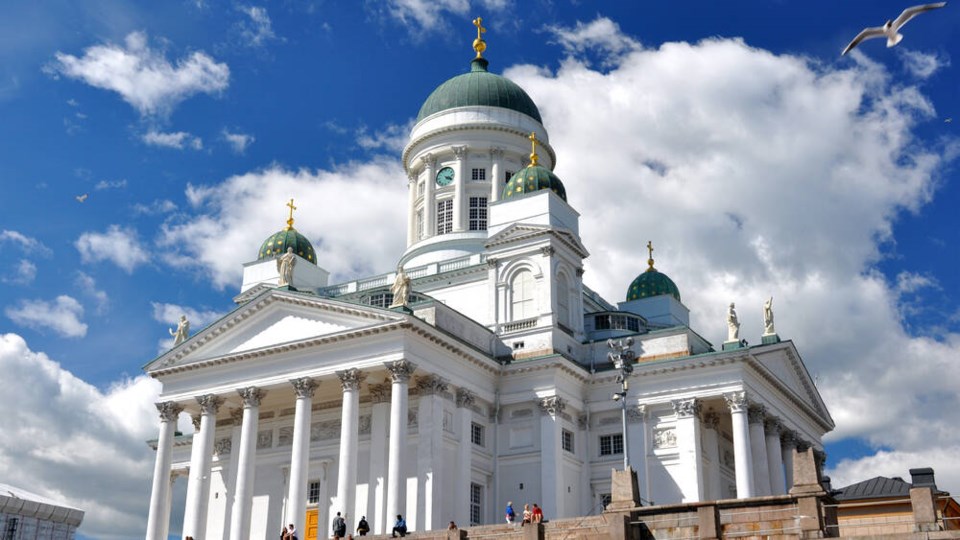There’s a definite energy on the streets of Helsinki tonight. My friend Hanne explains, “We call Wednesday our ‘little Friday.’ ”
People are filling up the city’s main boulevard. There are so many people that I wonder if it’s some kind of demonstration. Then I see their robes and sheets of music and realize that these are choral groups, each represented by a placard. From all corners of the country, some 800 singers converge on the massive steps of the Lutheran Cathedral, overlooking the Neoclassical Senate Square. Crowds gather, enthusiastic to hear this annual massing of the choirs.
The crowd quiets and the singers begin a rousing series of hymns. While I can’t understand a word, the songs are sung with such a stirring air that I imagine they tell both of the Finns’ hard-fought history, their solid faith, and their gratitude to be who they are — the people of Finland. As the last hymn ends, balloons are freed, and the singers disperse, kicking off a festive initiative called “Art Goes to the Pubs.” The city’s watering holes are about to be filled with song.
Leaving the square, we stop at the curb. There’s no traffic, so I jaywalk across the street. I get halfway across the boulevard before looking back for Hanne, who is still waiting for a walk signal. In defeat, I return to the curb. She says, “In Finland, we wait. It can be two in the morning and not a car in sight, but we wait.”
I note that Germans respect authority, too.
Hanne says it’s different in Finland. “We buck authority. But we follow the laws…even little ones. That’s why we have such low crime.”
Hanne points out an elegant restaurant with a dining hall that was perfectly preserved from the 1930s. Its Alvar Aalto–designed functionalism is the kind of straight design and practical elegance Finns love. Inside, a private office party is raging — specifically, a crayfish party. Crayfish are in season, but at $10 each, they are hardly a budget meal. Yet all over town Finns are doing the crayfish tango: Suck and savour a red mini-lobster, throw down a glass of schnapps, sing a song, and do it again. The 99 Bottles of Beer repetition just gets more fun with each round.
Hanne shows me the table where Carl Gustaf Emil Mannerheim, Finland’s sixth president, always sat. He was the heroic George Washington of modern Finland, who led the feisty resistance against the USSR. Many Finns consider him personally responsible for keeping their country free during and after the Second World War. No Finnish military leader will ever again hold Mannerheim’s rank of “field marshal.” But anyone can suck a crayfish at his favourite table.
We continue walking, ending up back where we started, on the grand Senate Square. The city seems a tale of two cultures. The late-setting sun gleams on both the Lutheran Cathedral and the golden onion domes of the Russian Orthodox Church. They seem to face off, symbolizing how east and west have long confronted each other here in Finland. Europe’s second-mightiest sea fortress — after Gibraltar — fills an island in the harbour, which allowed the village of Helsinki to grow into a booming capital.
Finns have a fun-loving confidence and seem to live well. I ask Hanne how Nordic Europe can be so prosperous when only Norway has oil.
She responds, “Norway has oil — Finland has Nokia. It’s like how Microsoft is for you in Seattle.”
“So, what’s Sweden’s trick?” I ask.
Hanne sighs, showing the standard Scandinavian envy of the regional powerhouse. “They never get in a war. They’re always rich…just collecting money all the time. The Swedes are like our big brother. They always win. Like in ice hockey. We won only once, back in the 1990s. The Swedes — assuming they’d win — had already written their victory song. But we won. We Finns still sing this song to give the Swedes a hard time. It’s the only song Finns know in Swedish and every Finn can sing it…even today.”
Our conversation is interrupted by a different song — a rousing hymn. Across the square is a church choir, marching to yet another Helsinki pub as if going to battle in a war for music.
— This article was adapted from Rick’s new book, For the Love of Europe.
writes European guidebooks, hosts travel shows on public TV and radio, and organizes European tours. You can email Rick at [email protected] and follow his blog on Facebook.


